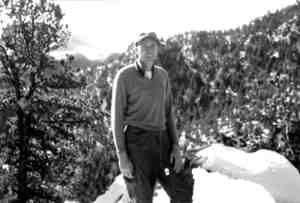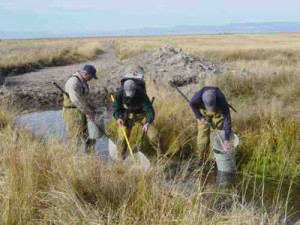Review by Ed Quillen
History – May 2007 – Colorado Central Magazine
This Soldier Life – The Diaries of Romine H. Ostrander, – 1863 and 1865, Colorado Territory
Annotated by Paul H. Malkoski
Published in 2006 by the Colorado Historical Society
ISBN 0-942576-51-9
COLORADO TERRITORY was something of a backwater during the American Civil War, but the U.S. Army did operate out here. Mostly the soldiers fought Indians — or slaughtered Indians, as at Sand Creek in 1864.
But Colorado units were part of an actual battle against Confederate soldiers at the Battle of Glorieta Pass in March of 1862 in New Mexico, and after thwarting that attempted invasion, they patrolled in Colorado and adjacent territories. Sorting out just which units did what can be confusing, since some units were local militia, under territorial authority, and others were U.S. Army under direct federal authority. The federal forces, in turn, were divided into “regulars” and “volunteers.”
Romine H. Ostrander was a private in the volunteer First Colorado Cavalry. Born in 1837 and hailing from Roseville, Ill., he probably came west to prospect, then joined the Army when the Civil War broke out. On Feb. 26, 1863, he bought a diary and kept it reasonably up to date throughout the year, though he observed that there were many days that were so tedious that it took considerable imagination to find something worth noting.
Presumably, he also kept a diary in 1864, but it has yet to surface; he did keep one for most of 1865. The 1863 and 1865 journals were found in 1922 in a warehouse in California, and now they’re published.
What do we learn from these? For one thing, not much has changed about Army life in some respects. There’s plenty of tedium and lots of “hurry up and wait,” and privates frequently grumble. They also gamble and brawl. They stand watch, prepare for inspections, and perform “fatigue details.”
Ostrander’s 1863 daily diary starts in late February. On the preceding pages, he crossed out the dates, and recorded his memories of the New Mexico campaign a year earlier. His spelling and grammar indicate that he didn’t have much of an education. He has some chilling recollections, such as this close brush with opening friendly fire:
“… I found that if I let me eyes remain fixed upon one object for any length of time I was actually going to sleep with my eyes open. I had roused myself out of one of those spells and on looking around I saw an Indian not over five paces from me sitting squatted on the ground and looking at me. As quick as thought I cocked my carbine without noise (which can be done, be pressing the finger on the trigger, and to which I had practiced myself) and brought it to my face and was on the point of firing when I saw that it was George Sowe, who had (being probably impressed with the necessity of silance) noiselessly crept out to attend to the wants of nature. When I saw who it was a shudder passed through me such as I had never experienced before.”
After those recollections, the diary moves to day-by-day mode, and local readers will likely be most interested in a patrol that began at Camp Weld (near pioneer Denver, and now long gone) from April 15 to July 18, 1863. The soldiers believed they were in pursuit of Confederate guerrillas who were terrorizing the miners and ranchers in and around South Park. But actually they were after the Espinosa gang, although the soldiers didn’t know that.
Their route from Denver to South Park was roughly that of modern U.S. 285. They even ventured over Trout Creek Pass before heading to Cañon City and back to Denver.
Here’s his entry for April 18:
“After travailing about five miles this morning we came down a big hill into the south park. It does not look as I expected it would. It is a kind of bason of prarie surrounded by high mountains on three sides and covered with hills in the southern part of it…. The hills are capped with pine and look black in the distance and they are all over it except the northern end. We left Taryall about three miles to our right and came into Fairplay twenty five miles. It is a very small town of log houses and dirt roofs. It has been pretty windy today and quite cold.”
After passing the salt works, the cavalry patrol crossed Trout Creek Pass. On April 21, “The boys left the pack animals for Strupe and me to drive and we had an awful time of it for the packs kept coming off and we travailed like h–l. We went down trout creek to the Arkansas river and down it to Brownsville and as we could find out nothing about the payhamkers [presumably the alleged guerrillas] we came back to trout creek and camped for the night having travailed thirty five miles today.”
YOU WISH HE’D gone into more detail about what he saw, but this was a personal diary, never designed for others to read. Ostrander’s patrols took him across much of the Eastern Slope, as well as into Wyoming and New Mexico. He also spent time as a hospital attendant, which made him want to get back out on patrol.
Ostrander delivered his opinion of the Sand Creek Massacre, which happened in 1864 (the missing in-between diary year) and involved soldiers he knew. On Jan 24, 1865, two months after the massacre, he was in camp with some of those soldiers, and wrote “I have pretty spirited arguments with these third reg’t ducks sometimes about the barbarity of indiscriminantly murdering defenseless women and children of the Indians at sand creek. Some of them deny that any thing of the kind was done except in the general action when there was no telling the difference; and some acknowledge that there were women and children killed after the general action was over; but argue that it was right because the Indians would have done the same.”
This little book was enjoyable for the first-hand accounts of Colorado Territory, as well as the opportunity to get to know, to some degree, someone who lived 140 years ago. There are useful maps and copious explanatory notes.
I wish there had been a chapter or two added to explain more about the frontier army and its organization, as well as the aims of the campaigns. As it is, This Soldier Life is mostly of interest to the hard-core history buff, rather than the general reader.



